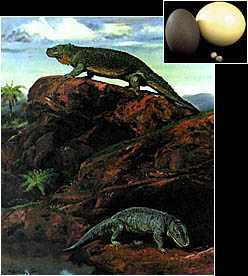
Enveloping Eggs

Amphibians transform into reptiles with a grand innovation: internal fertilization, which results in the "closed" egg. A new class of vertebrates spins off, generating the Great Age of the Reptiles. The reptiles' new reproductive strategy allows them to move inland to drier territories where they rapidly expand the vertebrate presence on land.
Egg architecture evolves. A biomineralized shell prevents fluids from evaporating and protects the growing embryo. Separate compartments for pantry and for waste are easily accessed by the embryo.
Bottom: This herbivorous reptile, just under two meters in length, represents the transition from amphibian to reptile. (Illustration by Zdenek Burian, © Jiri Hochman and Martin Hochman)
Glossary | Printer copy of this page (Opens a new browser)
All contents © 2000 Stiftung Drittes Millennium | Questions or comments, Email the Webmaster